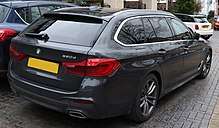Station wagon
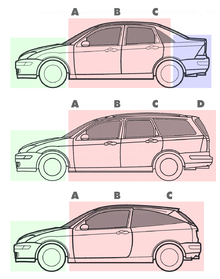
A station wagon, also called an estate car, estate wagon, or simply wagon or estate, is an automotive body-style variant of a sedan/saloon with its roof extended rearward[1] over a shared passenger/cargo volume with access at the back via a third or fifth door (the liftgate or tailgate), instead of a trunk/boot lid. The body style transforms a standard three-box design into a two-box design — to include an A, B, and C-pillar, as well as a D-pillar. Station wagons can flexibly reconfigure their interior volume via fold-down rear seats to prioritize either passenger or cargo volume.
The American Heritage Dictionary defines a station wagon as "an automobile with one or more rows of folding or removable seats behind the driver and no luggage compartment but an area behind the seats into which suitcases, parcels, etc., can be loaded through a tailgate."[2]
When a model range includes multiple body styles, such as sedan, hatchback, and station wagon, the models typically share their platform, drivetrain and bodywork forward of the A-pillar. In 1969, Popular Mechanics said, "Station wagon-style ... follows that of the production sedan of which it is the counterpart. Most are on the same wheelbase, offer the same transmission and engine options, and the same comfort and convenience options."[3]
Station wagons have evolved from their early use as specialized vehicles to carry people and luggage to and from a train station, and have been marketed worldwide.
Name
Station wagon and wagon are the common names in American, Canadian, New Zealand, Australian and African English, while estate car and estate are common in the rest of the English-speaking world. Both names recall the car's role as a shuttle, with storage space for baggage, between country estates and train stations.
Having shared antecedents with the British shooting-brake (originally a wooden-bodied vehicle used to carry shooting parties with their equipment and game), station wagons have been marketed as breaks, using the French term (which is sometimes given fully as break de chasse, literally "hunting break." Early U.S. models often had exposed wooden bodies and were therefore called woodies.[4]
Manufacturers may designate station wagons across various model lines with a proprietary nameplate. Examples include "Estate" (Mercedes-Benz, Chevrolets with the fake-wood option), "Avant" (Audi), "Touring" (BMW), "Tourer" and "Cross-Tourer" (Citroën), "SW" for Station Wagon or Sports Wagon (Peugeot), Estate (Renault), MCV (Renault/Dacia), "Tourer" (Rover), Kombi or Variant (Volkswagen and Saab) and "Sports Tourer", "SW - Sportswagon" (Kia) or Caravan (Opel).
Distinction from hatchbacks
Both station wagons and hatchbacks typically share a two-box design configuration, with one shared, flexible, interior volume for passengers and cargo[5][6] — and a rear door for cargo access.[7][8] Further distinctions are highly variable:
Pillars: Both configurations typically feature A, B & C-pillars; station wagons feature a D-pillar and hatchbacks may feature a D-pillar.
Cargo Volume: Station wagons prioritize passenger and cargo volume — with windows aside the cargo volume. Of the two body styles, a station wagon roof (viewed in profile) more likely extends to the very rearmost of the vehicle, enclosing a full-height cargo volume[6] — a hatchback roof (especially a liftback roof) might more likely rake down steeply behind the C-Pillar, prioritizing style[1] over interior volume, with shorter rear overhang and with smaller windows (or no windows) aside the cargo volume.
Cargo floor contour: Favoring cargo capacity, a station wagon may prioritize a fold-flat floor, whereas a hatchback would more likely allow a cargo floor with pronounced contour (e.g. the new Mini or the sixth generation Ford Fiesta).
Seating: Station wagons may have two or three rows of seats (e.g., the Ford Taurus wagons), while hatchbacks may only have one or two.[5]
Rear suspension: A station wagon may include reconfigured rear suspension for additional load capacity[1] and to minimize intrusion in the cargo volume (e.g., worldwide versions of the first generation Ford Focus).
Rear Door: Hatchbacks typically feature a top-hinged liftgate for cargo access, with variations ranging from a two-part liftgate/tailgates (e.g., the 1958 A40 Countryman) to a complex tailgate that can function either as a full tailgate or as a trunk lid (e.g., the 2008 Škoda Superb's TwinDoor). Station wagons have also enjoyed numerous tailgate configurations. Hatchbacks may be called Liftbacks when the opening area is very sloped and the door is lifted up to open.[5]
Automotive journalist Dan Neil, in a 2002 New York Times report described verticality of the rear cargo door as the prime distinction between a hatchback and a station wagon: "Where you break the roofline, at what angle, defines the spirit of the vehicle", he said. "You could have a 90-degree break in the back and have a station wagon."[9]
A model range may include multiple configurations, as with the 2005–2007 Ford Focus which offered sedan (ZX4), wagon (ZXW) and three and five-door hatchback (ZX3 and ZX5) models.
History
Woodies

The first station wagons were a product of the age of train travel. They were originally called "depot hacks" because they worked around train depots as hacks (short for hackney carriage, an old name for taxis). They also came to be known as "carryalls" and "suburbans".
Before the 1930s, manufacturers assembled the framing of passenger compartments of passenger vehicles in hardwood. In automobiles, the framing was sheathed in steel and coated with colored lacquer for protection. Eventually, all-steel bodies were adopted because of their strength, cost, and durability.[10]
Early station wagons evolved from trucks and were viewed as commercial vehicles (along with vans and pickup trucks), not consumer automobiles—with the framing of the early station wagons left unsheathed because of the commercial nature of the vehicles. This would be reflected on those vehicles registrations--Pennsylvania, for instance, issued special "Suburban" license plates well into the 1960s, long after station wagons became car-based. Early station wagons were fixed roof vehicles, but lacked the glass that would normally enclose the passenger compartment, and had only bench seats.[11] In lieu of glass, side curtains of canvas could be unrolled. More rigid curtains could be snapped in place to protect passengers from the elements outside.
In 1922 Essex introduced the first affordable enclosed automobile (sedan), which shifted the auto industry away from open vehicles to meet consumer demand for enclosed automobiles.[12]
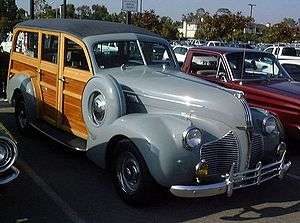
Initially, manufacture of the wagon's passenger compartments was outsourced to custom body builders because the production of the all-wood bodies was very time consuming. Major producers of wood-bodied station wagons included Mitchell Bentley, Hercules, USB&F, Cantrell, and other custom builders. The roofs of "woodie" wagons were usually made of stretched canvas that was treated with a waterproofing dressing. In 1919, the Stoughton Wagon Company of Stoughton, Wisconsin, had begun putting custom wagon bodies on Model T chassis.[11] By 1929 Ford was by far the biggest seller of station wagons. Since Ford owned its own hardwood forest and mills, at the Ford Iron Mountain Plant in the Michigan Upper Peninsula, it began supplying the wood components for the Model A wagon (although initially some final assembly still took place away from the factory, by Briggs, in Detroit, with wood from the Mengel Company in Louisville, Kentucky).[11] The same year, J. T. Cantrell provided woodie bodies for Chrysler vehicles until 1931.[11]
Eventually, the car companies began producing their own station wagons. In 1923 Star (a division of Durant Motors) became the first car company to offer a station wagon assembled on its production line (using a wooden wagon body shipped in from an outside supplier.)[13]
By the mid-1930s, wood-bodied station wagons had some prestige. They were priced higher than regular cars and were popular in affluent communities. When it was introduced in 1941 the Chrysler Town & Country was the most expensive car in the company's lineup.
Woodie wagons required constant maintenance: bodies were finished in varnishes that required recoating; bolts and screws required periodic tightening as wood expanded and contracted through the seasons.
The popularity of woodies was to a limited extent renewed, in the surfing culture, during the 1950s and 1960s.
All-steel wagons
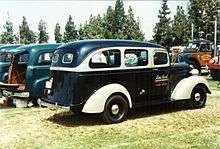
In 1935, General Motors introduced an eight-seat Chevrolet Suburban with an all-steel station-wagon body, based on the commercial Chevrolet truck-chassis.[11]
After World War II, automobile production resumed, with prewar tooling. New advances in production techniques made all-steel station wagon bodies more practical, eliminating the cost, noise, and maintenance associated with wood bodies.[14]
The first factory-built all-steel station wagon in North America was the 1946 Willys Station Wagon, based on the Jeep produced by Willys-Overland during World War II.[15][16] Willys offered a trim level, evoking earlier wood bodywork, rendered instead in paint and trim work. In 1947, Crosley also introduced an all-steel wagon version of their 1946 model CC car.
In 1949, Plymouth introduced the first all-steel station wagon in the U.S., the two-door Suburban, based on an automobile platform. In 1950 Plymouth discontinued the woodie station wagon, converting to all steel bodywork. Buick discontinued production of the last North American wood bodywork after the 1953 model year. Morris of England continued to market its Morris Minor Traveller until the late 1960s.
During the mid-1950s real wood accents replaced all wood sides, and by the late 1950s, the accents had been reduced to being simulated wood as durable, automotive-grade vinyl graphic appliqués were introduced in the mid-1950.[17] For example, only the very first Ford Country Squire had real wood accents, most were built with simulated woodgrain paneling.[18] By 1955, only Ford and Mercury offered a woodie model,[19] accomplishing the simulation of wood with other materials, e.g., steel, plastics and DI-NOC (a vinyl product).[20]

The Ford Country Sedan was actually a station wagon, they called it a sedan to highlight it was for personal ownership rather than taxi or other commercial use, as historically station wagons were for taxi style or hire car, hotel convenience vehicle, etc. services.
Ford was undoubtedly the most known for the use of woodgrain appliques on its vehicles. In addition to the well-known Country Squire, the "Squire" trim level was an available option in a few different model ranges. These include the Falcon Squire, Fairlane Squire, and in the 1970s the Pinto Squire. Surviving examples of these smaller "Squire" wagons are much rarer than the more popular full-size Country Squire, which was ordered and produced in much higher quantities. The Squire was always the highest trim level of any Ford Wagon and included the signature woodgrain applique, and usually additional exterior chrome, nicer interior trim, special emblems, etc. Other manufacturers marketed wagons and minivans with simulated wood from the mid-1950s through the early 1990s. The most notable of these are the Chrysler Town & Country, Buick Estate, Oldsmobile Custom Cruiser, Chevrolet Kingswood Estate, and Mercury Colony Park. The full-sized Jeep Grand Wagoneer also became recognized by its signature wood grained trim.[21][22] Simulated wood appliqués became less common in the 1980s. With the introduction of the retro-styled Chrysler PT Cruiser wagon-like model, aftermarket firms began selling simulated woodgrain kits.
Station wagons experienced highest production levels in the United States from the 1950s through the 1970s. The late 1950s through the mid-1960s was also the period of greatest variation in body styles, with pillared two- and four-door models marketed alongside hardtop (no B-pillar) four-door models (e.g., American Motors' Rambler Cross-Country wagons).[23] Rambler offered a four-door of this body style in 1956, followed by Mercury, Oldsmobile, and Buick in 1957; Chrysler entered the market in 1960. The pillarless designs could be expensive to produce, added wind noise, and created structural issues with body torque.[24] GM eliminated the hardtop wagon from its lineup in 1959, and AMC and Ford exited the field beginning with their 1960 and 1961 vehicles, leaving Chrysler and Dodge with the body style through the 1964 model year.
Full-size wagons
Traditionally, full-sized American station wagons were configured for six or nine passengers. The basic arrangement for seating six was three passengers in the front and three passengers in the rear, all on bench-type seats; to accommodate nine, a third bench seat was installed in the rear cargo area, over the rear axle. Through 1956, all wagons had the third row facing forward, but Chrysler's 1957 models had a roof too low to permit a forward-facing seat installed over the axle, so it was turned around and placed behind the axle. GM wagons would adopt the rear-facing third row with 1959 models until 1971, and again in 1977.
In full-size Ford and Mercury wagons built after 1964, the configuration was two seats facing each other, placed behind the rear axle. According to Ford, each seat would accommodate two people, raising the total seating capacity to ten passengers; however, these seats were quite narrow in later models and could accommodate only one passenger, limiting the total capacity to eight passengers.
The 1964–1972 Oldsmobile Vista Cruiser and 1964–1969 Buick Sport Wagon featured raised rooflines beginning above the second-row seat and continuing all the way to the rear tailgate. Above the second seat were acrylic glass skylights in which passengers could view the outside from overhead. On the three-seat models of these wagons, the third seat faced forward as did the first and second seats. Later, the 1971–1976 full-size "clamshell" wagons used a similar raised roof to provide adequate headroom for a forward-facing third row, but without the skylights.
Recent models of station wagons are usually built on smaller platforms and accommodate five or six passengers (depending on whether bucket or bench seats are fitted in front) in two rows of seating. The Mercedes-Benz E-Class Estate, a mid-sized station wagon, has an optional rear-facing jump seat for two passengers in the cargo area.
Full-size station wagons have been replaced by medium or full-size SUVs (both light truck and crossover types) with three-row seating such as the Chevrolet Suburban, Ford Expedition, and Mercedes-Benz GL-Class.
Two-door wagons
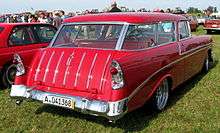
The first two-door station wagon was the 1946 Willys Jeep Station Wagon.[25]
In 1951, the compact 100-inch (2,540 mm) wheelbase Nash Rambler line included a two-door station wagon design whose production continued through 1955.[26]
In 1954 and 1955 the Studebaker Conestoga available only as a two-door station wagon.[27] In 1956, Studebaker introduced three new two-door wagons in Pelham, Parkview, and Pinehurst trims.[28]
The 1955–1957 Chevrolet Nomad and the larger, heavier, as well as more the powerful and expensive Pontiac Safari were two-door station wagons.[29]
For the 1957 and 1958 model years, Ford produced the Del Rio two-door wagon.[30] Mercury marketed a two-door hardtop (no "B-pillar") station wagon from 1957 to 1960, in the Commuter and Voyager trims.[31] The 1958 Edsel Roundup was a base model two-door wagon.[32]
After the merger of Nash and Hudson, the new company, American Motors (AMC) reintroduced the two-door wagon in the "new" Rambler American line in 1958.[33] It was "recycling" with only a few modifications from the original version and targeted buyers looking for "no-frills" economy.[34] American Motors' strategy of reintroducing an old design made for two distinct model runs, a successful business decision that is almost unheard of in automobile history.[35]
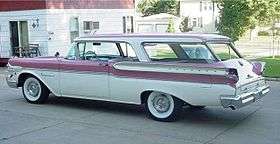
Starting in 1959, the Studebaker Lark was offered in a two-door station wagon body style.[36]
In 1961 Volkswagen introduced the Type 3 (also known in various markets as the Variant and the Volkswagen 1500 - later the Volkswagen 1600), available as a two-door sedan and as a two-door station wagon, which was commonly called the Squareback. VW's then-typical rear-engine layout was retained for the Type 3, but the engine profile was flattened, resulting in a small car offering interior room, as well as trunk space in the front. The model was offered through the 1973 model year.
Chevrolet produced the 1964–1965 Chevelle 300 series two-door station wagon.
The 1970s were a high point for two-door wagons in the U.S. as GM, Ford, and AMC fielded examples in their subcompact car lines.
The Chevrolet Vega Kammback, introduced in September 1970, was the first U.S.-made four-passenger wagon and the first two-door wagon from GM in six years. It shared its wheelbase and length with Vega coupe versions and was produced in the 1971–1977 model years. The Pontiac Astre Safari wagon is a Pontiac rebadged Vega that was introduced in the U.S for the 1975 model year. The Chevrolet Monza and Pontiac Sunbird Safari wagons replaced the Vega and Astre respectively. Retaining the Vega wagon body, they were produced for the 1978 and 1979 models years with Pontiac and Buick engines.
Ford Pinto and Mercury Bobcat 2-door wagons were produced between 1972 and 1980.
American Motors also offered a two-door wagon version of the AMC Pacer coupe from 1977 to 1980.[37][38]

The last two-door wagon available in America, the Volkswagen Fox, was discontinued in 1991.
In the United Kingdom, estate car versions of small and middle sized models were more common. The estate ("Traveller") versions of the Morris 1000 ("Minor") and Mini, with external ash wood frames (structural on the 1000); had two vertically divided van-type rear doors in the style of older shooting-brakes (see "station wagons around the world", below). The Hillman Husky estate version of the Hillman Imp was unusual in being a rear-engined estate. Other two-door station wagons in Europe included the Ford Escort, Morris 1100, Vauxhall Viva, Vauxhall Chevette, Fiat 127, and Saab 95.
A former East German car fleet made uniformly of Trabants and Wartburgs had a distinct luxurious version of a 2-door "estate coupe" Trabant 601 Estate with a C-column far back to extend the rear compartment of the car. This version had a full-scale liftgate allowing to access the entire rear room of nearly 1000 l with rear seats folded.
Popularity in North America
Since the 1970s, sales of station wagons in the United States and Canada declined for several reasons. The 1973 oil crisis was a turning point against the "traditional classic American station wagon—with its acres of fake woodgrain siding, sticky vinyl bench seats and lazy-revving V-8 engine", which have been described as "wallowing land arks".[39] The 1983 film National Lampoon's Vacation parodied the styling cues of 1970s station wagons with its garish Wagon Queen Family Truckster.
In 1984, Chrysler introduced the Chrysler minivans derived from the K platform. While the K platform was also used for the Plymouth Reliant and Dodge Aries station wagon models, the minivan would soon eclipse them in popularity. Since minivans and SUVs are classified as light trucks under US CAFE standards, manufacturers had a strong incentive to market those vehicles over station wagons, which are classified as cars. Station wagons have remained popular in Europe[40] and other locations whose emissions and efficiency regulations do not distinguish between cars and light trucks.[41]
.jpg)
The emergence and popularity of SUVs which closely approximate the traditional wagon bodystyle was a further blow. After struggling sales, the Chevrolet Caprice and the Buick Roadmaster, the last American full-size wagons, were discontinued in 1996. The Ford Taurus wagon was discontinued after the 2005 model year. The Dodge Magnum was marketed during the 2005–2008 model years.

Since then, smaller wagons have been sold in the United States as cheaper alternatives to SUVs and minivans. Domestic wagons also remained in the Ford, Mercury, and Saturn lines until 2004 when the bodies began a phase-out, replaced by car-based crossover SUVs and minivans designed to resemble station wagons.
Subaru has been a notable exception to this, offering full-size Legacy and Outback station wagon models in the United States and worldwide consistently from 1989 to the present day. These models continue to be produced at the Subaru of Indiana plant in Lafayette, IN.
The last subcompact station wagon produced in the United States and Canada was the 1992 Toyota Corolla. Compact station wagons have been declining since the 2000s. Ford dropped the Ford Focus ZXW wagon after its 2007 model year, and Subaru replaced the Subaru Impreza wagon with a 5-door hatchback model. Volvo announced that they intended to withdraw their compact station wagon, the Volvo V50, from the U.S market in 2012 due to poor sales. The Volvo V50 remains popular in Europe, however.[42] The VW Golf Sportwagen is Volkswagen's mid-2015 attempt to rectify the absence of a subcompact wagon from any manufacturer in the North American market.
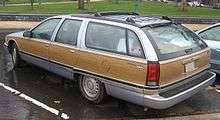
European luxury carmakers such as Audi, BMW, and Mercedes-Benz continued to offer wagons in their North American lineup, using the labels "Avant", "Touring", and "Estate" instead of wagon. However, these wagons had fewer trim and powertrain levels than their sedan counterparts,[39] for instance, the wagon styles of high-performance trims such as the BMW M5 and Audi RS6 were never imported to North America. The Mercedes-Benz E63 AMG in Estate trim is the sole performance wagon offered in the U.S. market. The Mercedes-Benz W204 wagon was not offered in the United States and Canada unlike the previous generation. The BMW 5 Series Touring was dropped from BMW's North American lineup after the conclusion of the E60 generation, due to slow sales in the United States with only 400 wagons sold in 2009.[43] Due to the popularity of SUVs in North America, these European manufacturers have been supplanting their wagons with car-based crossovers such as the BMW Sports Activity Series, the Audi Q5, and Mercedes-Benz M-Class, with these models offering a wider range of options and engines than wagons.
However, the Cadillac CTS gave rise to its wagon counterpart, the 2010 CTS Sportwagon. Unlike European luxury wagons sold in North America, the CTS Sportwagon has almost as many trim levels as its sedan counterpart.[39] The CTS wagon was discontinued in 2014. Volvo reintroduced a large wagon to the US market with the 2016 V90, but only by special order.[44]
Europe
European car manufacturers often built two-door station wagons in the post-war period for the compact class, a practice that continued at Ford (amongst others) with its Escort Mark III well into the 1980s. By that time, manufacturers developed four-door models. The market took off around this time, as station wagons became less cargo-oriented. Total European sales of station wagons amounted to 5.4% of the market in 1983, and were growing steadily. Switzerland was an early adopter; station wagons represented 15% of the market there in 1983.[45] In Europe, these vehicles remain popular and in volume production, although minivans (known in Europe as MPVs—multi-purpose vehicles) and the like have expanded into this market segment. As in North America, early station wagons were aftermarket conversions and had their new bodywork built with a wooden frame, sometimes with wooden panels, sometimes steel. Station wagons were the originators of fold-down seats to accommodate passengers or extend boot space.
Station wagons are generally called estate cars or simply estates in the United Kingdom. The term shooting-brake, a term for an original hunting vehicle, came to be known synonymously with station wagon and were also custom-built as modified luxury coupés with an estate car-like back. They generally retain two side doors. Until the early-1960s, many of them were built with structural wooden rear frames, making them some of the most expensive and luxurious "woodies" ever built.
Most small cars produced in the UK from the 1950s until the 1980s had Estate versions, some of which were also used as small delivery vans; minus the rear windows. By the mid-1950s, most British car manufacturers offered at least one estate model. Manufacturers often chose a specific model name to apply to all their estate cars as a marketing exercise – for example Austin used the Countryman name and Morris estates were called Travellers. The famous wood-framed Morris Minor Traveller was produced from 1952-71 and larger Morris Oxford Travellers were produced during the same time, initially also with wood-framed bodies but in five-door all-steel form from 1957 onwards. Some British estate cars were closely derived from existing commercial van models – such as the Austin A30/35 Countryman and the Hillman Husky while the Morris Travellers, the Austin Cambridge Countryman and the Standard Ten Companion were bespoke. One of the smallest estate cars ever made was the two-door Countryman/Traveller version of the Mini, initially available with or without (purely cosmetic) wood framing for the rear body – an option that was dropped in 1970 when the model was revised to become the more upmarket Mini Clubman Estate, which stayed in production until 1980.
.jpg)
Despite the popularity of station wagons in America, the two U.S.-owned manufacturers present in the UK (Ford and Vauxhall) were both relative latecomers to the estate car market, but the Ford Consul and Vauxhall Cresta were available as estates via factory-approved conversions from specialist coachbuilders such as Friary and Farnham. An exception was the original Vauxhall Victor, which was available from the factory as an all-steel five-door estate from 1958 onwards. Both saloon and estate Victors shared their styling with the 1957 Chevrolet. Ford and Vauxhall would produce their own factory-built estates on all three of their respective core models (small-, mid- and large-size cars) by the 1970s. The Europe-designed Ford Granada was available as a five-door estate from the start, joining the mid-size Cortina which had had an estate version since 1963, with simulated wooden side trim until 1966. The FD- and FE-Series Vauxhall Victors, built between 1966-78, were very large cars by British standards and featured estate models in the style of an American station wagon with front and rear bench seats and large-capacity petrol engines.
Rover and Austin produced 4×4 canvas-topped utility vehicles in the 1950s that were available in estate car body styles that were sold as "Station Wagons". They incorporated better seating and trim than standard editions with options such as heaters. Early advertising for the Land Rover version took the name literally, showing the vehicle collecting people and goods from a railway station.
Germany is the largest market for station wagons in the world. Some 600-700,000 vehicles are sold there each year, amounting to some 20% of all car sales.[46] The German language generally describes station wagons as Kombinationskraftwagen ("combination motor vehicle") or Kombi for short. During the 1980s, Volkswagen Polo crossed car categories by offering a two-door station wagon shape (not named as a wagon) as the main model in its range in some markets.
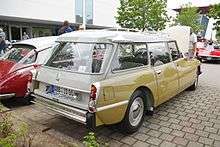
.jpg)
In France, almost all station wagon models are called the Break (with a different spelling from the English shooting brake). French breaks from Peugeot and Citroën were available in seven- or eight-seater "family" versions long before MPVs became known in Europe. The break version of the Citroën ID, introduced in 1958, was the first European model to offer the same size, style and luxury as an American full-size station wagon (prior to this breaks had been basic semi-commercial vehicles more like the American 'suburban'). The ID Break (known as the Safari in English-speaking countries) had the same eight-passenger seating arrangement as many American station wagons with two front-facing bench seats and two folding inward-facing seats in the load bed. The 'Familiale' version had a front bench seat, a forward-facing three-space bench seat in the middle and a folding forward-facing three-seat bench in the rear, providing a versatile nine-seater car. The Citroën also boasted an American-style two-part tailgate while its unique hydropneumatic suspension provided both self-levelling and automatic brake biasing regardless of the load carried. The car could also 'kneel' to the ground for easy loading of heavy or large items. The successors to the ID, the CX and XM, continued the tradition of offering some of the largest estate cars in Europe but the XM's replacement, the C6 was only produced as a saloon. The Peugeot 404, introduced in 1960, offered a conventional alternative to the innovative Citroëns for buyers wanting a large estate car. Its replacement, the 505 was available in both five-seat and seven-seat 'Familiale' versions. As with the Citroëns, changing demands in the French car market led to the end of the large Peugeot estate models in the mid-1990s, with the smaller and less versatile Peugeot 406 becoming the largest estate model in the range from 1995. In a similar situation to the United States, the decline of traditional Break and Familiale models in France was in no small part due to the introduction of the minivan in the form of the Renault Espace in 1984. Renault had never had a strong presence in the market for Breaks (favouring smaller cars with pioneering hatchback bodies such as the Renault 4 and Renault 16) and the Espace proved more modern, more economical and often more versatile than the traditional estate.
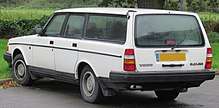
Volvo has a long history of estate cars, starting with the Volvo Duett of 1953. This was conceived rather like an American "suburban" as a dual-function delivery van and people-carrier and was based on the same platform and body design as a panel van, in turn based on the PV Series saloon. The PV's replacement, the Amazon, was available as a five-door all-steel estate with a horizontal split tailgate from 1962. The following 140 Series and 200 Series were also built as estates/wagons and sold well. The 200 Series was introduced in 1974 and the estate models gained a strong following in the United States, offering a smaller, more fuel-efficient alternative to the full-size American station wagon but with good build quality and reliable and a strong emphasis on safety which appealed to families. The engineering of Volvos and import duties in America and other European countries such as the UK made the cars relatively expensive, giving them a certain prestige appeal which was rare for estate cars previously seen as utilitarian. The later 700 Series was designed with American tastes in mind with regard to size and styling and in many markets the estate models significantly outsold the saloons. In the 1990s, Volvo offered estates tailored to both the American (900 Series) and European (Volvo 850) markets, but the decline in popularity of large estate cars during the decade led to both models being replaced by a single more European-sized V70 model in 1996, which was deemed a large estate car in Europe but a mid-sized station wagon in North America. Sales declined further until this model was dropped from the company's U.S. lineup for the 2011 model year, ending nearly forty years of the characteristic Volvo estate in America. The bigger V90 replaced the V70 in Europe in 2016 and is currently available in North America only through special order.
The Mercedes-Benz E-Class and Volvo V70 are examples of seven-seater estates not manufactured by the French manufacturers.
In the rest of the world

Japanese manufacturers did not build station wagons in large volume until recently. Models marketed as passenger station wagons in export markets were often sold as utilitarian "van" models in the home market. Some were not updated for consecutive generations in a model's life in Japan: for example, while a sedan might have a model life of four years, the wagon served for eight years, such as the 1979 Toyota Corolla (built until 1987) and the 1987 Mazda Capella (built until 1996). The Nissan Avenir is an example of a model that began its life as a utility vehicle and became a passenger car in the 1990s. Toyota no longer builds a wagon version of the Camry, but has wagon versions of Corolla or Auris, as well as Avensis. Station wagons remain popular in Japan with the likes of Subaru Levorg and Toyota Corolla Fielder, although they are in slow decline as the SUVs and minivans have taken over a large portion of this market.
In Australia and New Zealand the most popular station wagons were the large Ford Falcon and Holden Commodore models, although the Falcon wagon ceased production in 2010 due to wagons being replaced by SUVs in the Australian marketplace. The Commodore is slated for discontinuation in 2017.[47] These are usually built on a longer wheelbase than their sedan counterparts, though they share the same door skins, leading to a slightly unusual appearance with the rear door not reaching all the way to the rear wheel arch. Traditional station wagons in Australia have seen a major market share decline since the early 2000s as they are replaced by medium and large SUVs.
South Korean manufacturer Kia produce both the Cee'd and Optima estates designated as Sportswagons with sister company Hyundai offering estate versions of the i30 and i40.
In China, both foreign and local manufacturers have started to introduce wagons to the market as the trend started to rise.
Tailgate evolution
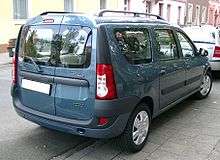
Many modern station wagons have an upward-swinging, full-width, full-height rear door supported on gas springs — often where the rear window can swing up independently. Historically, wagons have employed numerous designs:
- Split gate: The earliest common style was an upward-swinging window combined with a downward swinging tailgate. Both were manually operated. This configuration generally prevailed from the earliest origins of the wagon bodystyle in the 1920s through the 1940s. It remained in use through 1960 on several models offered by Ford, including the 1957-58 Del Rio two-door wagon. This style was later adopted on aftermarket camper shells for pickup trucks, seeing that pickup trucks already had a bottom half tailgate as an OEM feature.
- Retractable window: In the early 1950s, tailgates with hand-cranked roll-down rear windows began to appear. Later in the decade, electric power was applied to the tailgate window—it could be operated from the driver's seat, as well as by the keyhole in the rear door. By the early 1960s, this arrangement was common on both full-size and compact wagons.
- Side hinge: A side hinged tailgate that opened like a door was offered on three-seat wagons to make it easier for the back row passengers to enter and exit their rear-facing seats. This was later supplanted by the dual-hinged tailgate.
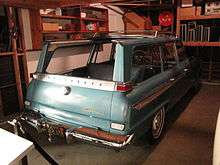
- Retractable roof: These have a retractable rear roof section as well as a conventional rear tailgate which folded down to carry tall objects that would not fit otherwise. The configuration appeared on the Studebaker Wagonaire station wagon and 2003 GMC Envoy XUV.
- Dual and tri-operating gates: Ford's full-size wagons for 1966 introduced a system marketed as "Magic Doorgate" — a conventional tailgate with retracting rear glass, where the tailgate could either fold down or pivot open on a side hinge — with the rear window retracted in either case. Competitors marketed their versions as a Drop and Swing or Dual Action Tailgate.[3] For 1969, Ford incorporated a design that allowed the rear glass to remain up or down when the door pivoted open on its side hinge, marketing the system, which had been engineered by Donald N. Frey[48] as the "Three-Way Magic Doorgate". Similar configurations became the standard on full-size and intermediate wagons from GM, Ford, and Chrysler. GM added a notch in the rear bumper that acted as a step plate; to fill the gap, a small portion of bumper was attached to the doorgate. When opened as a swinging door, this part of the bumper moved away, allowing the depression in the bumper to provide a "step" to ease entry; when the gate was opened by being lowered or raised to a closed position, the chrome section remained in place making the bumper "whole".
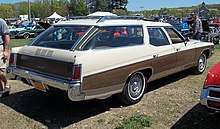
- Clamshell: Full-size General Motors 1971–1976 wagons — the Chevrolet Kingswood, Townsman, Brookwood, Belair and Caprice Estates; Pontiac Safari and Grand Safari; Oldsmobile Custom Cruiser, and the Buick Estate models — featured a 'clamshell' design marketed as the Glide-away tailgate, also called a "disappearing" tailgate because when open, the tailgate was completely out of view. On the clamshell design, the rear power-operated glass slid up into the roof and the lower tailgate (with either manual or optional power operation), lowered completely below the load floor. The manual lower tailgate was counterbalanced by a torque rod similar to the torque rods used in holding a trunk lid open, requiring a 35 lb push to fully lower the gate. Raising the manual gate required a 5 lb pull via a handhold integral to the top edge of the retractable gate.[49] The power operation of both upper glass and lower tailgate became standard equipment in later model years. Wagons with the design featured an optional third row of forward-facing seats accessed by the rear side doors and a folding second-row seat — and could accommodate a 4 x 8' sheet of plywood with rear seats folded. The clamshell design required no increased footprint or operational area to open, allowing a user to stand at the cargo opening without impediment of a door — for example, in a closed garage. Subsequent GM full-size wagons reverted to the doorgate style for its full-size wagons.
- Liftgate: A simplified, one-piece liftgate on smaller wagons. Subsequent generation of GM's full-size wagons returned to the upward-lifting rear window as had been used in the 1940s.
- Swing-up window: An upward-lifting, full-height, full-width rear door, where the window on the rear door can be opened independently from the rear door itself. The window is also opened upwards and is held on gas struts. The Renault Laguna II estate and Ford Taurus wagon featured this arrangement.
- Fold-up license plate: Wagons (including the Volvo Amazon wagon, early models of the Range-Rover, and the Subaru Baja) had an upward folding hinged plate attached to the lower tailgate of the split rear door. When the tailgate was folded down, the plate hung down and remained readable. The wagon versions of the Citroen DS, variously called the Break, Familiale or Safari, had a different solution- two number plates were fitted to the tailgate at right angles to each other so one would be visible in either position.
Safety equipment
Some station wagons are fitted with additional front-facing or rear-facing seats, along with safety belts, to enable passengers to be carried safely in the cargo area.
Cargo barriers may be used to prevent unsecured cargo from causing injuries in the event of sudden deceleration, collision, or a rollover.[50]
See also
Notes
- 1 2 3 Hillier, Victor; Coombes, Peter (2004). Hillier's Fundamentals of Motor Vehicle Technology: Volume 1 (5th ed.). Nelson Thornes. p. 11. ISBN 978-0-7487-8082-2. Retrieved 15 January 2013.
The estate body, also known as station wagons in some countries, has the roofline extended to the rear of the body to enlarge its internal capacity. Folding the rear seats down gives a large floor area for the carriage of luggage or goods. Stronger suspension springs are fitted at the rear to support the extra load. Hatchback: The hatchback is generally based on a saloon body but with the boot or trunk area blended into the centre section of the body. The hatchback is therefore halfway between a saloon and estate car. This type of body is very popular due to its versatility and style. Although some hatchbacks are in fact saloon bodies with the boot or trunk effectively removed (usually the smaller cars), many hatchbacks retain the full length of the saloon but the roofline extends down to the rear of the vehicle. As with the saloon bodies, a hatchback can have two or four passenger doors, however there is a tendency to refer to hatchbacks as three or five doors because the rear compartment lid (or tailgate) is also referred to as a door on the hatchback bodies. As with the estate, the rear seats fold down to give a flat floor for the transportation of luggage or other objects. When the tailgate is closed, the luggage compartment is usually covered with a parcel shelf.
- ↑ "Definition: Station Wagon". American Heritage Dictionary. Retrieved 13 January 2013.
- 1 2 Hartford, Bill (February 1969). "Sizing up the 1969 Station Wagons". Popular Mechanics: 106. Retrieved 23 November 2010.
- ↑ Street Rodder, 7/94, p.90 caption.
- 1 2 3 Jazar, G. Nakhaie (2008). Vehicle Dynamics: Theory and Application. Springer-Verlag. pp. 30, 1.8.3 Passenger Car Body Styles. ISBN 978-0-387-74243-4. Retrieved 23 November 2010.
Hatchback: Hatchback cars are identified by a rear door including the back window, that opens to access a storage area that is not separated from the rest of the passenger compartment. A hatchback may have two or four doors and two or four seats. They are also called three-door or five-door cars. A hatchback car is called a liftback when the opening area is very sloped and is lifted up to open. Station Wagon: A station wagon or wagon is a car with a full-height body all the way to the rear; the load carrying space created is accessed via a rear door or doors.
- 1 2 Erjavec, Jack (2004). Automotive Technology: a Systems Approach Chapter 4,. Cengage Learning. p. 55, Body Styles. ISBN 978-1-4018-4831-6. Retrieved 23 November 2010.
Liftback or Hatchback: The distinguishing feature of this vehicle is its luggage compartment, which is an extension of the passenger compartment. Access to the luggage compartment is gained through an upward opening hatch-type door. A car of this design can be a three- or five-door model; the third or fifth door is the rear hatch. Station Wagon: A station wagon is characterized by its roof which extends straight back, allowing a spacious interior luggage compartment in the rear. The rear door, which can be opened numerous ways depending on the model, provides access to the luggage compartment. Station wagons come in two and four-door models and have space for up to nine passengers.
- ↑ "Car Design Glossary - Part 2: One-Box (Monospace or Monovolume)". Car Design News. Retrieved 23 November 2010.
A three or five-door hatchback (no separate trunk compartment) is a 'two-box' car.
- ↑ Mike Mueller (2003). American Cars of the '50s. Crestline Imprints. ISBN 0-7603-1712-7.
- ↑ Neil, Dan (28 April 2002). "The Hatchback Is Back (but Nobody Uses the H-Word)". The New York Times. Retrieved 23 November 2010.
- ↑ G.N. Georgano, G. N. (2002). Cars: Early and Vintage, 1886–1930. Mason Crest. ISBN 978-1-59084-491-5.
Coincidentally, this benefited furniture makers, who previously had been outbid for the best wood
- 1 2 3 4 5 G.N. Georgano, G. N.
- ↑ Lamm, Michael; Holls, Dave (1996). A century of automotive style: 100 years of American car design. Lamm-Morada. p. 29. ISBN 9780932128072. Retrieved 30 June 2012.
- ↑ Mort, Norm (2010). American Woodies 1928-1953. Veloce Publishing Limited. p. 10. ISBN 978-1-845842-69-7. Retrieved 2017-05-12.
- ↑ Vance, Bill (24 March 2001). "Motoring Memories: The history of the station wagon". Autos Canada. Retrieved 15 January 2013.
- ↑ Cawthon, Bill (15 May 2002). "Jeep: From Station Wagon to Superstar". Retrieved 15 January 2013.
- ↑ Editors of Publications International (13 December 2007). "1945–1952 Jeep: Willys Postwar Jeep". auto.howstuffworks.com. Retrieved 15 January 2013.
- ↑ "Against the Grain: 21 Woodies That Weren't Station Wagons". Car and Driver. Retrieved 19 June 2017.
- ↑ Auto Editors of Consumer Guide (9 October 2007). "1950–1959 Ford Country Squire". howstuffworks com. Retrieved 6 August 2010.
- ↑ "1955 Ford Country Squire Station Wagon". National Museum of American History. Retrieved 15 January 2013.
- ↑ Litwin, Matthew (September 2009). "DI-NOC Siding: Restoring a station wagon's woodgrain is now quick and easy". Hemmings. Retrieved 19 June 2017.
- ↑ Garrett, Jerry (9 September 2015). "Jeep's Wagoneer Making Fake Wood Grain Fashionable Again?". Garrett on the Road. Retrieved 19 June 2017.
- ↑ Sean (15 June 2015). "A look back at the 1963 – 1991 Jeep Wagoneer: A guide to year-to-year changes". Classic Cars Today Online. Retrieved 19 June 2017.
- ↑ Collector Car Market Review (1999). "Postwar Station Wagons: Mom's Car Makes a Comeback". VMR International. Retrieved 15 January 2013.
- ↑ Schuon, Marshall (21 June 1992). "About Cars; Chewing Over the Art Of Automotive Design". The New York Times. Retrieved 15 January 2013.
- ↑ "Automotive History: The Short And Odd Life Of The Two Door Station Wagon". www.curbsideclassic.com. Retrieved 25 February 2018.
- ↑ Severson, Aaron (19 September 2009). "Fashionably Small: The Compact Nash Rambler". Ate Up With Motor. Retrieved 27 February 2018.
- ↑ Gunnell, John (2004). Standard Guide to 1950s American Cars. Krause Publications. p. 235. ISBN 9780873498685. Retrieved 27 February 2018.
- ↑ Flory Jr., J. "Kelly" (2008). American Cars, 1946–1959: Every Model, Year by Year. McFarland. p. 700. ISBN 9780786452309. Retrieved 27 February 2018.
- ↑ the Auto Editors of Consumer Guide (25 October 2007). "1955-1957 Pontiac Star Chief Safari". HowStuffWorks. Retrieved 27 February 2018.
- ↑ the Auto Editors of Consumer Guide (4 September 2007). "1958 Ford Del Rio". HowStuffWorks. Retrieved 27 February 2018.
- ↑ "Hardtop Styling: 1958 Mercury Voyager 2-door Wagon". Bring a Trailer. 24 February 2013. Retrieved 27 February 2018.
- ↑ Gunnell, John (2004). Standard Guide to 1950s American Cars. Krause Publications. p. 98. ISBN 9780873498685. Retrieved 27 February 2018.
- ↑ McNessor, Mike (July 2011). "1958-'60 Rambler American". www.hemmings.com. Hemmings Motor News. Retrieved 27 February 2018.
- ↑ Mattar, George (October 2007). "1958-1960 Rambler American". Hemmings Classic Car. Retrieved 27 February 2018.
- ↑ Vance, Bill (28 July 2006). "Motoring Memories: AMC Rambler American 1958-1960". Autos Canada. Retrieved 27 February 2018.
- ↑ the Auto Editors of Consumer Guide (26 October 2007). "Introduction to the 1959-1964 Studebaker Lark". HowStuffWorks. Retrieved 27 February 2018.
- ↑ "AMC Pacer Station Wagon is a Styling Coup!". Popular Mechanics. 146 (4): 96–178. October 1976. Retrieved 15 January 2013.
- ↑ Lamm, Michael (May 1977). "PM Owners Report: AMC Pacer Station Wagon No one feels wishy-washy about AMC's eye-catchingest wagon". Popular Mechanics. 147 (5): 92–93, 243. Retrieved 27 February 2018. }
- 1 2 3 Lorio, Joe (27 November 2009). "The Wagon of Cadillacs". The New York Times. Retrieved 7 March 2012.
- ↑ Heaps, Russ (7 November 2003). "Europe's station wagons flourish - The Washington Times". Highbeam.com. Retrieved 15 January 2013.
- ↑ An, Feng; Sauer, Amanda (December 2004). "Comparison of passenger vehicle economy and greenhouse gas emission standards around the world" (PDF). Pew Center on Global Climate Change. Retrieved 15 January 2013.
- ↑ Taylor III, Alex. "The death of the station wagon". autos.yahoo.com. Archived from the original on September 29, 2011. Retrieved 7 March 2012.
- ↑ "BMW Might Kill 5 Series Wagon in Favor of GT Crossover". Edmunds.com. 2009-07-08. Archived from the original on August 30, 2009. Retrieved 2009-09-27.
- ↑ "2018 Volvo V90 Wagon Will Be Custom Order Only in America". blog.caranddriver.com. Retrieved 2017-01-08.
- ↑ Meurer, Stany (1985-01-24). "Deux levres pour un hayon" [Two lips for one boot]. Le Moniteur de l'Automobile (in French). Brussels, Belgium: Editions Auto-Magazine. 36 (813): 25.
- ↑ Deutschland einig Kombiland
- ↑ Ford Falcon wagon dead, Drive.com.au, March 24, 2010
- ↑ "The Thinker (Detroit Style)". Time. April 21, 1967. Retrieved 10 October 2015.
- ↑ Norbye, Jan P.; Dunne, Jim (October 1970). "The '71 Wagons, Big Changes Coming Up". Popular Science: 74–75. Retrieved 10 October 2015.
- ↑ Byard, RW; Bourne, AJ; James, R (August 1999). "Childhood deaths and cargo barriers in cars". Journal of Pediatric Child Health. U.S. National Library of Medicine. 35 (4): 409–10. PMID 10457305.
References
- Gunnell, John, ed. (1987). The Standard Catalog of American Cars 1946–1975. Krause Publications. ISBN 978-0-87341-096-0.
- Kimes, Beverly R.; Clark, Henry A. (1996). The Standard Catalog of American Cars 1805–1945. Krause Publications. ISBN 978-0-87341-428-9.
- Narus, Donald J. (1977). The Great American Woodies and Wagons. Crestline Publications. ISBN 978-0-912612-13-3.
- Brown, Arch (April 1997). "Natural History: The 'Woody' Station Wagon Story — Part I". Collectible Automobile. 13 (6): 26–41.
External links

_%E2%80%93_Heckansicht%2C_3._April_2015%2C_D%C3%BCsseldorf.jpg)
